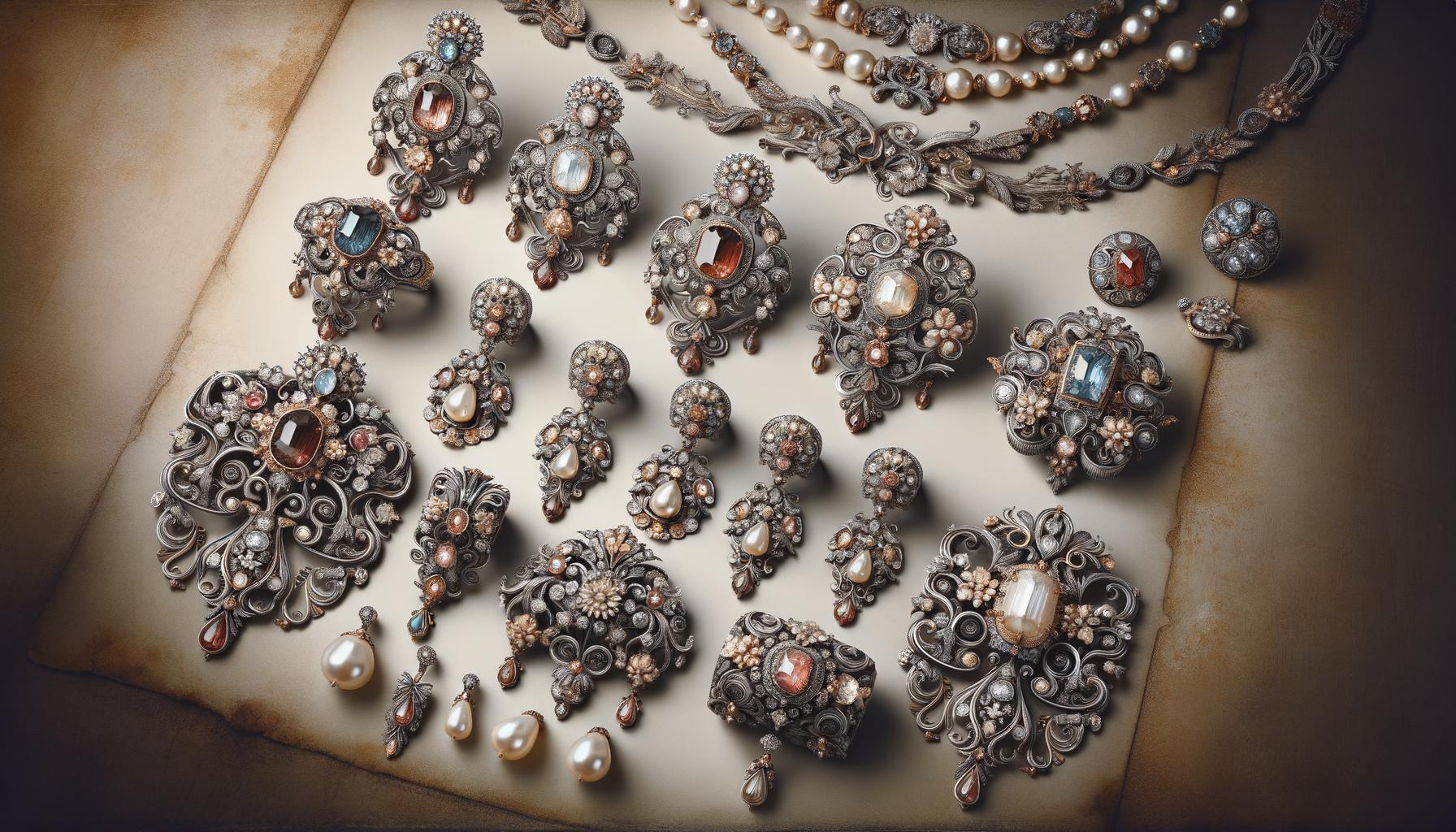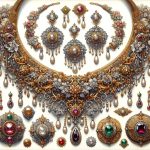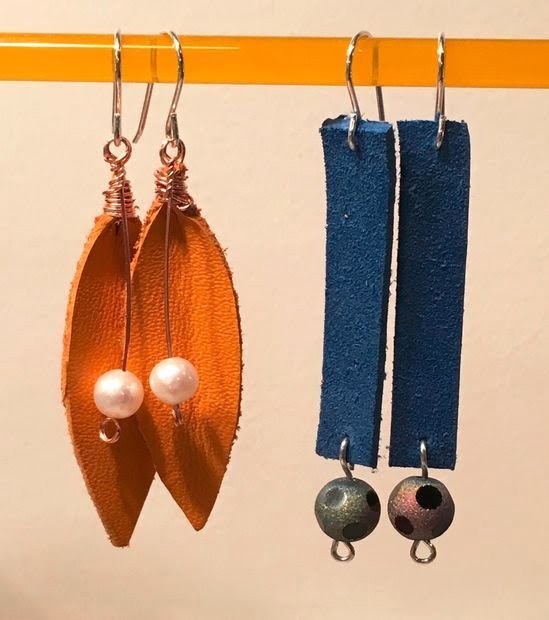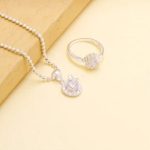Baroque jewelry: extravagance and ornamentation embodies an era of grandeur and sophistication that unfolded between the 17th to early 18th centuries. Originating in Europe, the Baroque period was marked by dramatic artistic expressions, and nowhere was this more evident than in its opulent jewelry. This epoch celebrated ornate designs that emphasized boldness, flowing curves, and rich contrasts-a testament to the social and cultural exuberance of the time.
Jewelry during the Baroque era was more than mere decoration; it was a powerful statement of wealth, status, and identity. From royal courts to affluent circles, extravagant adornment signified social standing and personal taste. Pieces were designed not only to complement luxurious fashion but also to convey authority and influence. This trend was prevalent among royalty, nobility, and influential figures who commissioned extraordinary jewels to showcase their prominence and power.
The theme of extravagance in Baroque jewelry is reflected through its excessive use of precious metals like gold and silver, coupled with lavish embellishments using pearls and gemstones. The designs often featured intricate details such as enamelwork, filigree patterns, and repoussé techniques that enhanced their ornamental appeal.
Central motifs included religious iconography, mythological references, naturalistic forms like flowers and foliage-all contributing to a stylistic language driven by opulence. This introduction offers merely a glimpse into the mesmerizing world of Baroque jewelry where artistry met grandeur in unparalleled splendor.
Historical Context
The origins of the Baroque movement can be traced back to early 17th century Europe, primarily flourishing in countries like Italy, Germany, France, and Spain. This cultural wave was a response to the Renaissance’s emphasis on balance and proportion, seeking instead to evoke grandeur through emotional exuberance and elaborate detail.
Rooted in these principles, baroque jewelry: extravagance and ornamentation served as a visual testament to this new artistic fervor. The period was marked by dramatic expressions not only in art but also in fashion and accessories, with jewelers pushing the boundaries of traditional craftsmanship.
Influence of the Catholic Church and Royalty
The Catholic Church played a significant role in propagating the Baroque aesthetic. As part of the Counter-Reformation effort, church officials commissioned awe-inspiring pieces of art and jewelry designed to captivate followers. These objects often featured religious symbols such as crosses, angels, saints, and other divine figures rendered in exquisite detail using the finest materials available. Just as cathedrals enveloped worshippers in ornate splendor, so too did baroque jewelry encapsulate spiritual reverence through its intricate designs.
Royalty also heavily influenced Baroque jewelry trends. Monarchs like Louis XIV of France embraced the opulence associated with this era by adorning themselves with ornate gem-encrusted pieces that reflected their status and power. Jewelry became an essential element of court culture-a means for rulers to project authority and wealth. The crown jewels from various European monarchies remain some of the most extraordinary examples of Baroque design sensibilities.
Socio-Political Climate
The socio-political climate during the Baroque period further fueled its extravagant trends. The consolidation of absolute monarchies created a hierarchical society where visual splendor was synonymous with political strength. Nobles emulated their kings by commissioning elaborate pieces that showcased their own affluence and refined tastes. In this environment, baroque jewelry: extravagance and ornamentation became not just personal adornments but public declarations of loyalty and social rank.
This era also saw increased global trade bringing exotic materials into European markets-ivory from Africa, pearls from Asia-each serving as luxury accents in Baroque creations. This access widened jewelers’ palettes beyond local resources, allowing them to experiment more freely with textures and colors which were previously unavailable or too rare to use extensively.
Thus entwined within its historical context, Baroque jewelry emerges as an emblematic product of its time-deeply enmeshed within religious fervor, monarchical display, and social stratification-all while epitomizing boundless creativity unlocked by newfound material wealth through expanding global ties.
Design Characteristics of Baroque Jewelry
Dramatic Motifs and Forms
Baroque jewelry is renowned for its dramatic and often theatrical designs. A hallmark of the era, these pieces frequently featured intricate, flowing motifs that mimicked the grandeur and complexity found in Baroque architecture and painting. Common motifs included flowers, leaves, shells, and scrollwork. These elements were often arranged in asymmetrical patterns, giving Baroque jewelry a dynamic and lively appearance that emphasized movement and drama.
Embrace of Curves and Asymmetry
One of the most distinctive features of baroque jewelry: extravagance and ornamentation, was its use of curves and asymmetry. This design principle reflected the broader aesthetic preferences of the Baroque period, which favored fluidity over rigidity and symmetry.
Jewelers employed curving lines to create a sense of movement within their pieces, enhancing their visual impact. The combination of asymmetrical elements with symmetrical basics added depth and intrigue to each piece, making every item a unique masterpiece that stood out in any collection.
Influence From Architecture and Art
The exuberant style seen in Baroque jewelry was significantly influenced by contemporary developments in architecture and painting. Engravings resembling ornate columns or archways were common in necklaces, bracelets, and rings.
The lavish use of precious stones mirrored the opulence found in Baroque churches’ stained-glass windows or elaborate frescoes depicting scenes from mythology or religion. This crossover between different art forms not only highlighted the interconnectedness of cultural expressions during the period but also set a high standard for craftsmanship in baroque jewelry design.
Overall, the design characteristics of Baroque jewelry encapsulate an era defined by its pursuit of beauty through complexity, grandeur through intricacy-a perfect representation of baroque jewelry: extravagance and ornamentation at its finest.
Materials and Techniques
The creation of baroque jewelry during the 17th to early 18th centuries saw an opulent use of a variety of luxurious materials that underscored its emphasis on extravagance and ornamentation. Gold was a primary material, celebrated for its luster and malleability, allowing jewelers to create intricate designs.
Silver also played a significant role, often used as a base metal to support ornate embellishments. One couldn’t overlook the lavish use of pearls-particularly natural ones-which were highly coveted for their rarity and iridescence, adding an extra layer of splendor to any piece.
Not limited to metals and pearls, Baroque jewelry featured an extensive selection of precious stones like diamonds, rubies, sapphires, and emeralds. These gems were not merely set into the pieces but often strategically placed to maximize light reflection and enhance their visual impact.
Enamelwork was another popular technique used to add vivid colors to these ornate creations. Enameling allowed artists to incorporate rich hues ranging from deep cobalt blues to vibrant reds, often integrating these colored segments into religious or mythological themes intrinsic to Baroque art.
The technical artistry behind Baroque jewelry was equally impressive. Techniques such as filigree-where thin threads of gold or silver were twisted into intricate patterns-resulted in some of the most delicate and elegant work ever seen in jewelry design. Repoussé work involved hammering metal from the reverse side to create detailed relief patterns on the front.
This method was especially popular for creating motifs inspired by nature or classical antiquity, which were common elements in Baroque jewelry’s thematic repertoire. Collectively, these innovative techniques exemplified the period’s unique blend of artistic creativity and masterful craftsmanship integral to baroque jewelry: extravagance and ornamentation at its finest.
Famous Baroque Jewelers and Their Masterpieces
The Baroque era witnessed the rise of several remarkable jewelers whose exquisite pieces embodied the opulence and ornate qualities synonymous with baroque jewelry: extravagance and ornamentation. One such master was Jean-Baptiste Tavernier, a French gem merchant and traveler, celebrated for his extensive trade expeditions across Persia and India.
Tavernier’s keen eye for precious gems allowed him to bring back some of the most extraordinary diamonds, including the famous “Tavernier Blue,” which would later become the Hope Diamond. His works were often characterized by an abundance of gemstones set in intricate designs that exemplified the lavishness of the Baroque period.
Another notable figure in the world of Baroque jewelry was Charles Le Brun, although primarily known as a painter and decorator for King Louis XIV. Le Brun’s contributions to jewelry design were profound, particularly in his capacity as director of arts for the court.
He oversaw the creation of countless ornate pieces meant to reflect the king’s wealth and power, integrating elements from his grand architectural projects into wearable forms. Le Brun’s ability to blend various art forms within his jewelry designs resulted in pieces that doubled as both accessories and miniature works of art.
In Italy, one could not overlook Alessandro Algardi, predominantly lauded for his work as a sculptor but who also dabbled in intricate jewelry designs commissioned by European royalty. Algardi’s expertise in creating dynamic compositions with deep reliefs translated flawlessly into his ornamental accessories, which bore religious motifs prevalent during that time.
These creations showcased not only exceptional craftsmanship but also served as symbols of faith and power among Europe’s elite. His gemstone-encrusted devotional pendants stood out distinctly with their detailed religious iconography set against baroque curves and swirls.
These jewelers’ masterpieces highlight how patronage played an essential role in bringing such elaborate creations to life during this period. Monarchs like Louis XIV heavily sponsored artisans like Tavernier, Le Brun, and Algardi to create extravagant jewelry pieces that symbolized their divine right to rule and unparalleled affluence. Consequently, these partnerships left behind a legacy rich with luxurious artifacts that continue to be admired for their artistic brilliance and historical significance today.
Symbolism in Baroque Jewelry
Baroque jewelry was infused with a profound sense of symbolism, making each piece not just an accessory but a narrative woven into metal and gemstone. Religious symbols were particularly significant during the Baroque era, reflecting the period’s deep Catholic roots. Crucifixes adorned with intricate enamelwork and pearls served as both symbols of faith and demonstrations of wealth.
The Madonna and Child figures rendered in gold and precious stones were common motifs that highlighted religiosity while showcasing remarkable craftsmanship. These religious symbols acted as both a spiritual safeguard for the wearer and as proof of their piety to society.
Mythological themes also played a crucial role in Baroque jewelry design, often drawing on classical antiquity for inspiration. Gods and goddesses from Greco-Roman mythology appeared frequently in cameos, pendants, and rings. For example, pieces depicting Venus represented love and beauty, while those featuring Hercules symbolized strength and valor.
The use of mythology allowed jewelers to craft elaborate narratives within a single brooch or necklace. Such items became conversation starters at social gatherings, helping wearers make statements about their own virtues or aspirations through the storied images they bore.
Nature-inspired symbolism was another hallmark of Baroque jewelry’s extravagance and ornamentation. Flora and fauna elements such as flowers, birds, fruits, and even insects were common themes that symbolized various human experiences like love, fertility, freedom, and transformation.
Roses crafted from rubies might signify passionate love while emerald leaves could represent growth and renewal. This intricate interplay between nature’s elements not only showcased the jeweler’s skill in replicating natural beauty but also imbued each piece with deeper meanings understood by contemporary viewers.
| Symbol | Meaning |
|---|---|
| Crucifix | Faith/Piety |
| Venus (Goddess) | Love/Beauty |
| Rose | Passionate Love |
Baroque Jewelry in Modern Times
In recent years, Baroque jewelry’s distinctive features have found a new life in modern fashion. Contemporary designers often draw inspiration from its extravagant and ornamental characteristics, integrating elements like bold curves, intricate patterns, and luxurious materials into their collections.
Many high-end fashion houses have reintroduced baroque jewelry: extravagance and ornamentation to create statement pieces that resonate with today’s trendsetters. The revival of these designs underscores not only the timeless appeal of Baroque aesthetics but also their adaptability to modern tastes.
Several contemporary designers have garnered attention for their Baroque-inspired creations. Alexander McQueen’s collections frequently showcased elaborate jewelry pieces featuring ornate metalwork and lush adornments reminiscent of the Baroque period. Dolce & Gabbana is another notable advocate, incorporating religious iconography and opulent gemstones into their designs, thus rekindling the Baroque spirit in haute couture. These reinterpretations not only pay homage to historical artistry but also push boundaries, blending classic designs with innovative techniques.
For those interested in adding a touch of Baroque elegance to their wardrobe today, there are numerous options available both in authentic antiques and replicas. Authentic pieces can be sought at specialized antique shops or auction houses where provenance can be verified by experts.
Replicas, on the other hand, offer an affordable way to indulge in this resurgent fashion trend without committing to hefty investments. Online marketplaces and boutique jewelers often carry a wide range of baroque-inspired accessories crafted with modern sensibilities while staying true to the essence of extravagance and ornamentation that defines the Baroque era.
- High-end fashion houses like Dolce & Gabbana infuse religious iconography into modern jewelry.
- Antique shops and auction houses are excellent places to find authentic Baroque pieces.
- Replicas can be found online for those preferring more accessible options.
Collecting and Caring for Baroque Jewelry
Collecting Baroque jewelry requires both a keen eye and an appreciation for the intricate craftsmanship that defines this opulent era. Intrigued collectors often start by educating themselves about the hallmark designs, materials, and motifs characteristic of Baroque jewelry: extravagance and ornamentation. Aspiring collectors should seek out reputable dealers and auction houses specializing in antique jewelry to ensure authenticity. Networking with other enthusiasts via online communities can also provide invaluable insights and leads on rare pieces.
When it comes to authenticating Baroque jewelry, attention to detail is crucial. Genuine Baroque pieces typically exhibit expert craftsmanship with elaborate designs featuring curves, asymmetry, and dramatic contrasts. Specific techniques such as enamelwork, filigree, and repoussé are hallmarks of the period. Look for well-documented provenance or certification from established appraisers to verify the authenticity of these intricate artifacts. Consulting books or articles focused on identifying period-specific characteristics can also aid in distinguishing genuine items from replicas.
Proper care and maintenance are vital to preserving the beauty of Baroque jewelry. Given their age and delicate construction, these pieces require careful handling and specific storage conditions to prevent damage. Place them individually in soft-lined compartments or wrap them in acid-free tissue paper to avoid scratches and tarnish.
Regular but gentle cleaning using non-corrosive methods will help retain their luster without compromising their structural integrity. Engaging professional conservators for periodic check-ups ensures longevity, allowing these masterpieces of baroque jewelry: extravagance and ornamentation to be admired by future generations.
Conclusion
Baroque jewelry remains a testament to the artistic innovation and opulence that characterized the 17th and early 18th centuries. Its enduring appeal lies in its intricate designs, lavish use of precious materials, and the sheer extravagance of its pieces.
The themes of ornamentation and grandeur continue to captivate collectors, historians, and fashion aficionados alike. Baroque jewelry is not merely a relic of the past but an enduring symbol of human creativity and a window into an era where art was marked by exuberance and emotional expression.
The lasting impact of Baroque style on the jewelry industry is evident in contemporary design trends. Modern jewelers frequently draw inspiration from Baroque motifs, incorporating elements such as elaborate scrollwork, dramatic contrasts, and rich textures into their creations.
This influence is found in high-fashion collections as well as bespoke pieces that aim to capture the spirit of extravagance and ornamentation intrinsic to baroque jewelry. As a result, Baroque-inspired designs continue to be celebrated for their timeless elegance and ability to evoke a sense of luxury.
However, beyond fashion trends, Baroque jewelry serves as a cultural artifact that bridges the gap between history and modernity. Collectors value these pieces not only for their beauty but also for their historical significance.
Authenticating and preserving these works require expertise and dedication, ensuring that each piece’s legacy is maintained for future generations. As more people rediscover the grandeur of Baroque artistry through exhibitions and scholarly works, it becomes clear that this period’s approach to jewelry-making remains unparalleled in its celebration of extravagance and ornamentation.
Resources and Further Reading
The Legacy of Baroque Jewelry remains a testament to humanity’s enduring fascination with grandeur and artistic excellence. With its roots deep in the opulent 17th and early 18th centuries, Baroque jewelry exemplifies a remarkable era where design was not merely about adornment but an elaborate display of skill, power, and cultural significance.
Through intricate motifs inspired by religious themes, nature, and mythology, these pieces are more than accessories; they are storied artifacts that speak volumes about the society from which they emerged.
Baroque jewelry’s extravagance and ornamentation have left an indelible mark on the evolution of jewelry-making. The techniques perfected during this period-such as enamelwork, filigree, and repouss-continue to inspire contemporary designers who seek to capture a semblance of that old-world brilliance in modern creations. This influence is evident as current fashion cycles through resurgences of Baroque-style elements, adapting them into today’s wearable art while maintaining their original intent: to awe and express sophistication.
Collecting Baroque jewelry today means becoming part of an ongoing narrative that spans centuries. Whether one invests in authentic pieces from reputable sources or opts for meticulously crafted replicas, the allure remains strong. Caring for these treasures ensures that future generations can continue to appreciate their aesthetic grandeur. As we look back on the legacy of Baroque jewelry, we celebrate a tradition steeped in artistry and cultural richness – a true homage to human creativity’s limitless bounds.
Frequently Asked Questions
What Are the Characteristics of Baroque Jewellery?
Baroque jewelry is characterized by its opulence, intricate designs, and use of rich materials. Originating in the early 17th century, it often features elaborate motifs such as flowers, scrollwork, and cherubs.
The craftsmanship involves techniques like enamel work and use of gemstones like diamonds, pearls, and emeralds set in ornate gold or silver settings. These pieces are highly decorative and display a flamboyance that reflects the grandeur of the Baroque period’s overall aesthetic.
What Is the Baroque Style of Ornamentation?
The Baroque style of ornamentation is defined by its elaborate detail, bold forms, and dramatic contrasts. This style emerged in Europe during the 17th century and extended through various art forms including architecture, painting, sculpture, and interior design.
Characterized by dynamic movement, grandeur, and exuberance, Baroque ornamentation frequently includes flowing lines, intricate patterns of foliage or flowers, volutes (spiral scrolls), and gilded surfaces. This approach to decoration seeks to evoke emotion and awe through its visual opulence.
Is Baroque Extravagant?
Yes, Baroque is considered extravagant due to its emphasis on grandeur and opulent details. Designed to impress and inspire awe among observers, this artistic style makes liberal use of luxurious materials such as gold leaf on architectural elements or richly colored marble inlaid with intricate designs.
Additionally, in its pursuit of dramatization—whether through theatrical sculptures or vividly dynamic paintings—Baroque art often incorporates highly detailed compositions aimed at creating a sense of movement and emotional engagement that goes beyond mere utility or function.

Welcome to my jewelry blog! My name is Sarah and I am the owner of this blog.
I love making jewelry and sharing my creations with others.
So whether you’re someone who loves wearing jewelry yourself or simply enjoys learning about it, be sure to check out my blog for insightful posts on everything related to this exciting topic!




